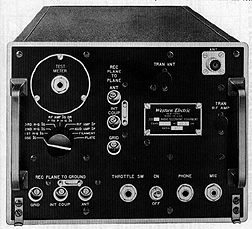AN/ARC-4 RADIO TELEPHONE EQUIPMENT (WE-233A)
Photo of a AN RT-19/ARC-4. Use.-Ground-air liaison. Frequency range.-l40 to 144 megacycles. Power output.-5-10 watts. Emission.-A3. Description.-The WE-233 radio telephone equipment is a VHF communication unit designed for aircraft use in the 140 to 144 Mc band. It is intended for two-way radio-telephone communication between airplanes and from airplanes to ground stations. It also provides an interphone system for the pilots. The equipment consists of a VHF transmitter and a VHF receiver mounted on a single chassis. Both the transmitter and receiver may be pre-tuned for operation on any four crystal controlled frequencies in the 140 to 144 Mc band. One of the four frequencies is intended for plane-to-plane communication. The remaining frequencies are intended for plane-to-ground communication. A transmitter crystal and a receiver crystal are mounted in a single crystal holder and are so selected that the transmitter and receiver both operate on the same carrier frequency. Crystal switching relays incorporated in the equipment permit rapid selection of any of the four pre-tuned carrier frequencies. The radio receiver has two independent r-f input circuits which permit simultaneous monitoring on two carrier frequencies. One input circuit may be used to monitor continuously on the plane-to-plane carrier frequency. The other input circuit may be used simultaneously to monitor any one of the plane-to-ground frequencies. Provision is made to temporarily disable either circuit if two signals are received at the same time. The WE-233 radio telephone equipment may be used interchangeably in airplanes equipped with either 12- or 24-volt d-c power supplies, provided the power receptacle on the apparatus mounting in the plane is properly wired and the proper dynamotor is inserted in the equipment. A single dynamotor provides high voltage supply for both the transmitter and the receiver and is transferred by means of a relay controlled by the press- to-talk switch on the microphone. The same relay also transfers the antenna to the receiver or to the transmitter. Tube complement: Transmitter: 6V6GT, Oscillator and tripler.
Receiver:
Frequency control.-Crystal. Power supplies available.-12 or 24 volts d-c. Operating power required:
Antenna.-A quarter-wave shunt fed antenna is recommended. The location of the antenna is determined by sliding it along the top of the fuselage and taking field strength readings at the rear of the airplane. The point or points where maximum radiation to the rear occurs are comparatively sharp and a matter of six inches means the difference between full output and a null. The antenna should be fed by a 50- to 70-ohm low loss coaxial transmission line. Dimensions and weight Unit | Type No. | Dimensions | Weight | | Inches | Pounds Radio set | WE-233 | 19 1/2 x 10 7/16 x 7 11/16 | 33 REFERENCES:The information enclosed here is excerpted from:Catalogue of Naval Electronic Equipment-April 1946- NavShips 900,116.
|

